by Maya Hammoud | Sep 25, 2023
Wilderness Medicine is easily the most unique rotation I’ve done in medical school. Run by the Department of Emergency Medicine, Wilderness Medicine teaches students how to provide quality medical care in outdoor settings with limited resources, while also offering immersive experiences in backpacking, rock climbing, caving, and more! Join me as I take you through my past month on this interesting and exciting rotation.

Camping at Pictured Rocks.
In the first week, we jumped right in with outdoor activities and lectures, interactive patient cases that may arise in the wild, a mass casualty simulation event, and orienteering. We learn by listening, but also by doing. Class is fun, engaging, and interactive.
The next week, we backpacked through Pictured Rocks in northern Michigan. The week was filled with beautiful experiences in nature, long hikes, daily “fireside chats” where students educate the group on a topic of their choosing, swimming in Lake Superior, learning to obtain and filter water in the wild, and, of course, camping at a new site each day. By the end of the week, we had developed a strong sense of comradery and accomplishment having backpacked 43 miles together through hot weather at first, then cold and rainy weather, all while fighting off blisters and mosquitos. Despite the struggles at times, the beauty of the nature around us, the freedom of being “unplugged” from phones and social media, and the independence of traveling by foot with all of our food, shelter, and supplies contained in backpacks provided a spectacular and unforgettable experience.
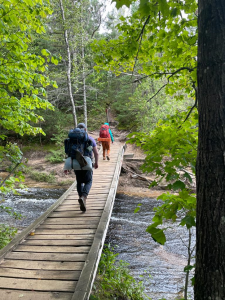
Backpacking at Pictured Rocks.
We had less than a week before our next trip, but in that time we managed to squeeze in kayaking, attending regional wilderness medicine rounds, mountain biking, and daily lectures.
Our next trip, and frankly my favorite part of the course, included rock climbing in Kentucky and caving in Indiana. I, along with several of my classmates, had never done either of these activities before, but we soon learned that we were to be led by experts and could make remarkable progress with no prior experience necessary!
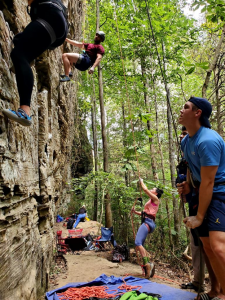
Climbing and belaying at the Red River Gorge.
We rock climbed in the Red River Gorge in Kentucky, a beautiful spot with thousands of natural rock walls of various heights and difficulty levels. It was great trying out the different climbs and watching our experienced resident leaders – Matt and Carlos – climb the more difficult rock walls. It was especially inspiring to see classmates who had a fear of heights overcome these fears and ascend multiple climbs! Climbing by day, we spent the evenings camping at Miguel’s and eating dinner at local spots in the small town of Slate, Kentucky.
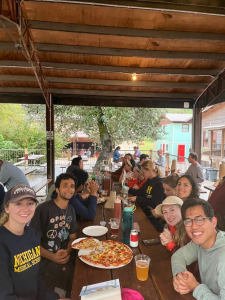
Dinner at Miguel’s.
After two eventful days of climbing, we drove up to Buckner Cave in Indiana. Here, we learned about and experienced exploring a “wild cave,” led by expert cavers Anmar and Jess. At times, the cave was barely a foot and a half tall, necessitating belly crawling or rolling to move forward. In other spots, we climbed up or down narrow passages, navigated around obstacles, or, rarely, were able to walk through open spaces.
We learned tricks to avoiding hypothermia in caves (hint: it involves a contractor bag and a candle!), medical considerations for evacuating patients from caves, and basic geology on how and why caves form. We also had a moment where everyone turned off their headlamps and sat perfectly still so we could meditate in the pitch-black darkness and perfect silence that is unique to caves. We debriefed and celebrated this unique experience with smores and hot dogs around the campfire on our last night camping together as a group.
The following day, having explored the cave once, we did a simulated evacuation of a “patient” (one of our classmates) from the cave. It required extensive teamwork and coordination, but we managed to carry our classmate out on a “litter” (similar to a stretcher) through all of the obstacles and tight spaces of the cave to safety.
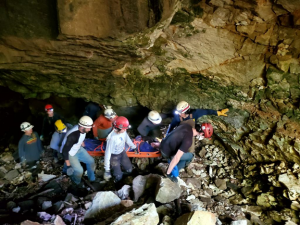
Extricating our “patient” from the cave.
After a team lunch, we drove back to Ann Arbor where we would finish up the course with a series of evidence-based medicine talks and a final exam of both written questions and scenario-based stations. Each student gave a talk on a wilderness medicine topic of their choosing, from managing obstetric emergencies in the wilderness to things that can go wrong while scuba diving or summiting mountains to the efficacy and importance of bug spray and sunscreen in the wild. We learned from each other, as we had throughout the course, both inside and outside of the classroom.
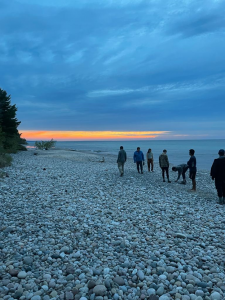
Sunset on Lake Superior.
As I reflect on the past month, I am in awe of how many new and unique experiences I have had in such a short span of time, as well as by the wealth of knowledge I have acquired on such a wide variety of wilderness medicine topics. Watching the sunset on Lake Superior, camping under the stars, scaling large rock walls in Kentucky, and exploring a cave 80 feet underground in Indiana were experiences my classmates and I will never forget. I wholeheartedly recommend this course for any student or prospective student whether or not they plan to pursue a career in wilderness medicine. I am so grateful for the amazing opportunity this course provided, as well as for the incredible resident and faculty leaders that made it happen.
Maya Hammoud is a fourth-year medical student at the University of Michigan. She is pursuing a career in general surgery, with an emphasis on medical education, clinical outcomes research, and improving diversity, equity, and inclusion in healthcare. In her free time she enjoys gymnastics, swimming, hiking, and reading.
by Lena Juratli | Aug 21, 2023
“I will erase my knees, I will eat it [my knees]…so that I will not kneel to an aggression, an army, or an era” – Muhammad Al-Maghout
سأمحو ركبتي بالممحاة , سآكلها .. حتى لا أجثو لعسكر أو تيار أو مرحلة. – محمد الماغوط
This profound quote originates from my late grandfather, the renowned Syrian poet and playwright, Muhammad Al-Maghout. His fearless exploration of contentious themes, deeply rooted in the socio-political context of the Arab world, alongside an unwavering dedication to Arab identity, social progress, and human rights, continues to resonate with modern thinkers and activists, solidifying his role as a transformative figure in Arab culture and intellectual discourse.

Me (left) and Noor Alesawy (right), one of Medical Arabic’s native speakers and a current master’s student at John Hopkins University.
Inspired by my grandfather’s enduring legacy, I embarked on my own transformative journey during the Branches – the inception of Medical Arabic in fall of 2022. As a University of Michigan medical student, I am resolute in upholding the values of justice, freedom, and human rights that he championed. This purpose is particularly resonant in southeast Michigan, where the state ranks as the second-largest haven for Arab Americans nationwide. The Detroit Metro Area, historically a magnet for Arab refugees and immigrants due to its vibrant automotive industry, encapsulates this cultural dynamism. It’s within this backdrop that Medical Arabic was developed, an innovative platform uniting over 700 healthcare professionals from across the United States in their pursuit of Arabic language proficiency.
This endeavor was born from my reflections on experiences with Arabic-speaking patients during my clinical year, including the unique challenges they faced in accessing healthcare. During my Step 1 study period, a flexible four-week window provided by the University of Michigan’s Medical School, I spent early mornings and late nights creating materials and worksheets to facilitate the language learning process, connecting with Middle Eastern and Arabic Language faculty at University of Michigan, and developing an innovative curriculum that would be feasible to run. I aimed for every student who joined Medical Arabic to forge a bridge—a bridge that transcends language, connecting hearts, healing communities, and uplifting the voice of every patient, regardless of the language they speak.
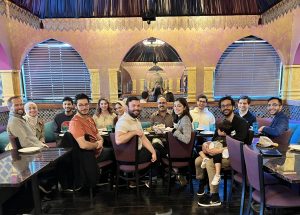
The executive board’s welcome lunch with our faculty advisors.
I actively sought perspectives from a diverse array of ethnic and religious groups who share Arabic as a common tongue, ensuring their meaningful representation within the framework of the Medical Arabic curriculum. This encompassed connecting with Egyptian Copts, Moroccan Jews, and Sudanese Christians, among other communities. I aspired to infuse the very essence of cultural richness and representational equity into the tapestry of the Medical Arabic curriculum through this spirited amalgamation of voices. I delved deep into the intricacies of medical education, the dynamics of healthcare leadership, and the intricately woven art of rallying support from a diverse community for a cause that had long remained overlooked and underrepresented.
Guided by the mentorship of Dr. Shahzad Mian, Dr. Emad Abou-Arab, and Professor Ibrahim Khalaylih, who have exhibited exceptional dedication to nurturing medical trainees at the University of Michigan, we seamlessly integrated healthcare perspectives into our content. Bringing this project to fruition required the collective effort of a diverse executive board, spanning multiethnic, multilingual, and multireligious backgrounds. Comprising medical, pharmacy, and dental students alongside undergraduates, this dynamic group worked together to meticulously craft curriculum and create content for our upcoming fall language workshops. With financial support from the Office of Multi-Ethnic Student Affairs, Dr. Abou-Arab’s Office for Health Equity and Inclusion grant, and the Gorenflo award from the Department of Family Medicine, our alliance rapidly drew together over 400 participants in just three months.
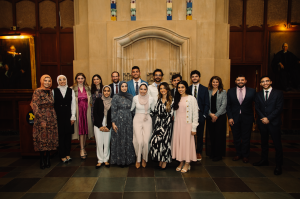
The executive board at our first annual Ramadan iftar.
Over the past year, we’ve organized a series of 12 language sessions catering to a range of skill levels. These sessions were complemented by culturally enriched seminars, drawing insights from Arab history, literature, and traditions. By integrating references to historical events, notable figures, and cherished cultural practices, we aimed to instill a deep sense of pride in Arab heritage. Our discussions ventured into essential themes, including Arab immigration trends in southeast Michigan, their influence on healthcare, barriers to healthcare screening, and more.
I created partnerships across campus, such as with Kellogg Eye Center’s Culture Committee, to host Arabic in Ophthalmology sessions. The impact was significant, drawing over 90 participants from Kellogg’s faculty and staff – a testament to the potency of language in creating bridges of understanding.
Our dedication to the community found expression through actions that extended beyond traditional boundaries. A poignant example is our initiative to provide free iftar meals to fasting healthcare professionals during Ramadan. This innovative endeavor marked a pioneering step at the University of Michigan, and its significance is further supported by its inclusion in a manuscript currently under review in a medical journal. In line with our partnership with El Harissa, I advocated for the donation of a portion of sales from the iftars to the Delonis Center, a local shelter that annually provides essential services and emergency shelter to approximately 1,200 individuals. Collaborations with local bookstores, like Literati in Ann Arbor, have allowed us to explore the significant literary works of Arab leaders, including a late winter book talk on the Syrian refugee experience. On a national stage, we proudly sponsored the 2023 Global Surgical Innovation Conference in Ann Arbor, advocating for equitable surgical care access in underserved regions worldwide.
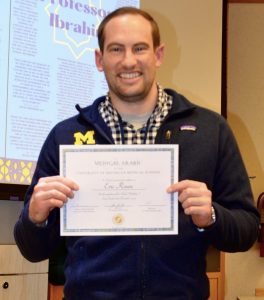
My classmate, M4 Eric, receiving his completion certificate.
Similar to Al-Maghout’s literary creations encompassing poetry, drama, and prose that advocated justice, freedom, and human rights, the core of Medical Arabic is grounded in the pursuit of these very ideals. Our movement operates as a conduit for unity and awareness, resonating with the transformative power of language. Through each interaction and connection we cultivate, Medical Arabic dismantles barriers, igniting impactful change.
As I reflect on these endeavors, a common thread of purpose emerges – a commitment to fostering connections, sparking change, and making a meaningful impact. Each collaboration and initiative supports the potential for transformation that lies within collective effort. In my medical career ahead, I carry forward this spirit, armed with the belief that purposeful actions, no matter how small, can create ripples of positive change that extend far beyond our immediate surroundings.
Lena Juratli is a fourth-year medical student at the University of Michigan Medical School. When she’s not achieving her daily German learning goal on Duolingo, you can find her exploring the latest Yemeni coffee shop in Dearborn with her siblings.
by Mustapha Jaber | Aug 17, 2023
Following my first year at the University of Michigan Medical School, I had the absolute privilege of being one of the four Health Equity Interns in the American Academy of Family Physicians (AAFP) Underrepresented in Medicine Health Equity Internship Program.
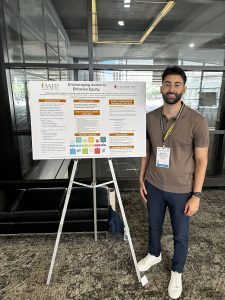
Presenting my work on the Social Determinants of Health Screening Action Guide at the AAFP National Conference in Kansas City, MO.
Throughout the summer, I engaged in learning about policy and commission making in healthcare. From the start, I had the honor of attending the Commission on Diversity, Equity, and Inclusiveness in Family Medicine, providing me an early vantage point to delve into health policy and witness the decision-making process shaping our healthcare landscape. Meeting leaders from around the nation and engaging with their expertise and perspectives on crucial issues left me enlightened.
One of the hallmarks of the internship program was the “Mentorship Mondays,” which afforded us the opportunity to meet and learn from Family Physicians from all around the country. It was amazing to meet inspirational physicians doing such diverse and impactful work. I left each meeting feeling empowered and inspired.
Additionally, to supplement our learning during the program, we were given a book called “The Political Determinants of Health” written by Daniel E. Dawes. This book was very insightful, providing an intricate dive into the forces and systems that have resulted in the disparities in health we see throughout history that are ever much present today. One of the major lessons I learned from reading this book, as well as our discussions with physicians, was the multitude of levels in which health disparities exist and conversely can be addressed. Starting from the individual patient encounter all the way to political structures, in order to properly address the health inequities we see today, we must have a comprehensive approach at all levels.
The core of the internship centered around developing action guides to improve the foundation of patient care and address social factors beyond the walls of the clinic. My role involved developing a guide to assist family physicians in identifying and addressing patients’ social needs. At first, I could not believe I would be working on such an important and impactful guide that would be used by family physicians across the entire country! I was equally excited and nervous to play such a pivotal role.
After a deep dive into the existing literature, it became apparent to me just how critical this guide will be. Did you know that clinical care is estimated to account for about 20% of health outcomes, whereas social determinants of health affect up to 50% of health outcomes (Hood CM)? The more I learned, the more I developed the guide by tailoring information to what seems to be most important for patients whose needs are not being met. Through introspection, I gained invaluable insights into my role as a future physician and what patient-centered care truly means.
Embarking on this uncharted process was inherently difficult, but I had the utmost privilege of being mentored by Dr. Margot Savoy. Our discussions and her unwavering support empowered me to visualize what I wanted the guide to be and the lasting impact I wanted to make. Her guidance encouraged us to take the lead and express our thoughts freely. This allowed me to write about my personal perspective on what is truly important to me and to the communities I deeply care about.
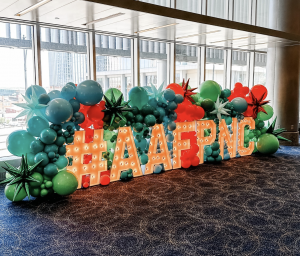
Photo Credit: American Academy of Family Physicians Instagram: (the_aafp)
In the midst of the program, I had the opportunity to travel to Kansas City, Missouri, and present an overview of the Social Determinants of Health Screening action guide at the AAFP National Conference! The conference was a transformative experience that opened my eyes to the critical work passionate individuals are doing across the world. I was able to attend discussions, listen to congressional reforms and network with peers from around the world. I could not help but feel a profound sense of purpose and commitment to my role in driving healthcare reform.
I am proud and honored to be a part of such an incredible and transformative program. I hope to take all the skills and knowledge I have gained thus far and use them throughout my career and to continue to be an agent of change.
References: Hood CM, Gennuso KP, Swain GR, Catlin BB. County Health Rankings: Relationships Between Determinant Factors and Health Outcomes. Am J Prev Med. 2016 Feb;50(2):129-35. doi: 10.1016/j.amepre.2015.08.024. Epub 2015 Oct 31. PMID: 26526164.
Mustapha Jaber is a rising second year Medical Student at the University of Michigan Medical School. He is the Co-founder of the Disabilities, Research, Education, Advocacy, Movement (DREAM), and is passionate about Health Equity. He enjoys all kinds of physical pursuits and is currently preparing for his first marathon!
by Alexandra Vita & CJ Schellack | Jul 21, 2023
Throughout medical school, we have the privilege of meeting patients with so many different life experiences. The physiology and pharmacology of medical illness is complex, but oftentimes we see that the external factors that lead to illness or injury are just as complex.
We’ve met patients with lung cancer, who have been exposed to heavy amounts of pollutants after factories were built close to their homes. We’ve seen people come into the emergency room with raging infections, who had to put off health care because they couldn’t afford the cost.
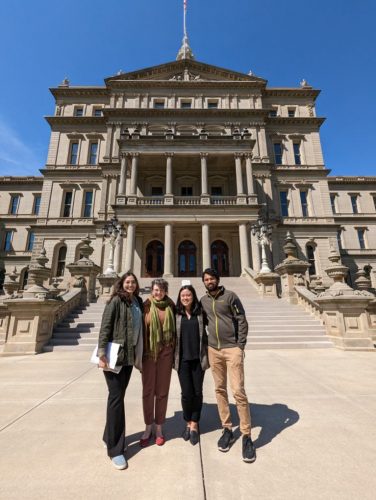 It is an honor to be with patients in these moments and support them in ways that we can. However, sometimes it feels like there are constraints within the healthcare system — we leave these patient interactions wishing there was more we could do to change these peoples’ circumstances. This desire to drive positive change for patients beyond the one-on-one clinical setting often takes shape in the form of advocacy work.
It is an honor to be with patients in these moments and support them in ways that we can. However, sometimes it feels like there are constraints within the healthcare system — we leave these patient interactions wishing there was more we could do to change these peoples’ circumstances. This desire to drive positive change for patients beyond the one-on-one clinical setting often takes shape in the form of advocacy work.
Dr. Megan Purdy, a recent UMMS graduate, created a longitudinal course alongside U-M emergency medicine physician Dr. Brad Uren that allows students to develop skills in advocacy. In the first class, many students talked about experiences where they noticed barriers to care. People had interests about access to care for OB-GYN populations, immigrant and refugee populations, incarcerated populations, patients with substance use disorder, and more. Everyone expressed the hope to address inequities in healthcare, but felt they needed guidance about how to effectively start.
The class was a small group format, with regular guest speakers and opportunities for questions and answers with the guests after their prepared comments. Some of the pilot class’s favorite speakers are listed below.
The course kicked off with a meeting with Dr. Kermit Jones, an internal medicine physician whose experiences drove him to run for office in California’s 3rd Congressional District. He candidly shared what he learned from running a campaign, and he encouraged us to amplify the voices of our patients. He reminded us that “If you’re not at the table, you’re on the menu.”
We met former U.S. Surgeon General Dr. Jerome Adams, who spoke about his experiences in the White House and how to serve communities from a national lens. He chatted with each student individually, providing thoughts and guidance about our specific interests.
We met with Megan Groen, the senior advisor to the Director of the Michigan Department of Health & Human Services who spoke about the recent successes and the future goals of MDHHS. Students working at the U-M Student-Run Free Clinic were vocal about how insurance and food security were large concerns of patients, and Ms. Groen directed students to different resources and programs to address these issues.
Dr. Rahul Gupta, the Director of National Drug Control Policy, appointed by President Biden as the first physician to hold that role, led a discussion about the landscape of the opioid epidemic and the different policies and programs that have recently come into effect.
This class created a unique space where every week, students had the rare opportunity to have in-depth discussions with people who have worked in policy and advocacy for decades. In a welcoming and low-pressure environment, students were encouraged to bring up their hopes and concerns. In turn, experts gave students advice about how to pursue their ideas. We worked with the Michigan Medicine communications team to learn about effective ways to write an op-ed. From chatting with the manager of state and federal government relations from the Michigan State Medical Society, we learned how to advocate for our interests with our local representatives.
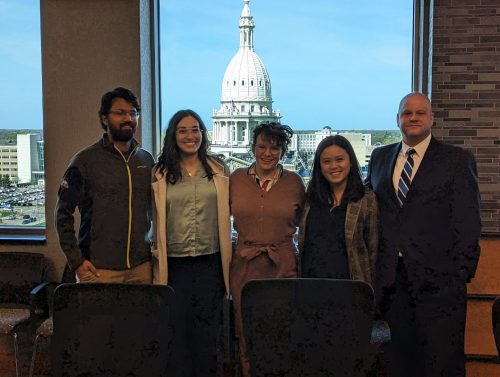 At the end of the course, students had the opportunity to travel to Lansing, where they spoke with Washtenaw County’s Rep. Carrie Rheingans and Sen. Jeff Irwin. Some students interested in emergency medicine elected to travel to Washington, D.C. and attend the American College of Emergency Physician’s Leadership and Advocacy Course with Dr. Uren. In future classes, students may also travel to the American Medical Association’s National Advocacy Conference in Washington DC. Other opportunities may be available for students with other specialty interests as well.
At the end of the course, students had the opportunity to travel to Lansing, where they spoke with Washtenaw County’s Rep. Carrie Rheingans and Sen. Jeff Irwin. Some students interested in emergency medicine elected to travel to Washington, D.C. and attend the American College of Emergency Physician’s Leadership and Advocacy Course with Dr. Uren. In future classes, students may also travel to the American Medical Association’s National Advocacy Conference in Washington DC. Other opportunities may be available for students with other specialty interests as well.
This class provided networking opportunities, taught us tangible skills and instilled hope that we can leverage our perspective as medical students to advocate for our patients’ well-being. We are excited to continue this course and invite students to join this upcoming Fall and Winter!
Alexandra Vita is a fourth-year medical student at the University of Michigan Medical School interested in public health and advocacy for immigrant populations. She will be applying into internal medicine this year.
CJ Schellack is a fourth-year medical student at the University of Michigan Medical School. She recently took a year off to get a Master in Public Health. She is applying into emergency medicine.
by Blake Hardin | Jul 20, 2023
Currently more than 1 in 4 adults in the United States in the United States have some form of disability, as reported by the Centers for Disease Control and Prevention. While disability affects many individuals in the U.S. and worldwide, this population is one of the most unrecognized groups and faces significant health disparities.
Individuals with disabilities struggle with healthcare access, as 1 in 4 adults with disabilities ages 18-44 years do not have a usual healthcare provider. Additionally, 1 in 5 adults with disabilities have an unmet healthcare need because of cost in the past year, and 1 in 4 adults with disabilities 45 to 64 years did not have a routine check-up in the past year.
Furthermore, people with disabilities report feeling unsatisfied with the healthcare they receive significantly more than people without disabilities. This could be partially explained by the fact that more than eighty percent of physicians in the U.S. believe those with disabilities have a worse quality of life than those without disabilities, which may significantly impact the quality of care physicians provide to these patients. Disability can impact many facets of one’s life, so people with disabilities need comprehensive and empathetic care from physicians who have been trained to provide culturally competent healthcare.
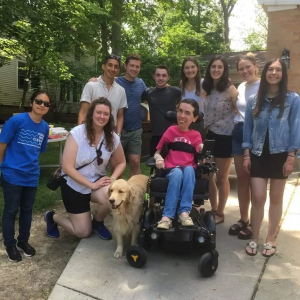
MSDHA members at a BBQ social event during Summer 2022.
Growing up with a chronic illness, I have firsthand knowledge and experience of the stigmatization and isolation one can face by having a disability or chronic illness outside of the healthcare setting. While I was fortunate to have a great healthcare experience, I know from friends and loved ones that this is often not the case. I was heavily involved in a disability advocacy group during undergrad to bring these issues to light and amplify the voices of those with disabilities, so I knew I wanted to continue this work in medical school.
Fortunately, a group of University of Michigan medical students also recognized this and founded the Medical Students for Disability Health and Advocacy (MSDHA) student organization in February 2021 to work to address these issues. MSDHA aims to promote disability health initiatives and support medical students with disabilities and chronic illnesses through education, community building, outreach, and advocacy. The organization strives to create an inclusive community of medical students to support one another throughout medical school and beyond. Creating a community of medical students with disabilities and allies is especially important because only about 1 in 20 medical students report having a disability, which is likely a gross underestimation of the true number of students who identify with having a disability. These students also face unique barriers throughout their medical education.
[Read about the University of Michigan Medical School’s Commitment to Support Students with Disabilities]
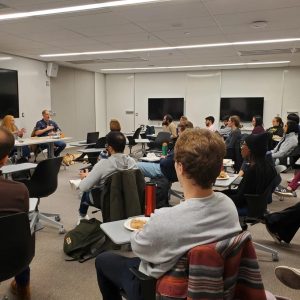
Medical students attending a patient panel on the healthcare experiences of Deaf and hard-of-hearing patients.
All medical students are welcome to join MSDHA and contribute to initiatives, plan events, facilitate mentorship, and build community. The organization offers a variety of programs and opportunities, including a near-peer mentorship program called Disability Connect, an American Sign Language (ASL) elective for medical students, hands-on opportunities to work with individuals with disabilities, and public events to spread awareness about disability health topics. In addition, MSDHA hosts social events to strengthen the community.
Recently, MSDHA members hosted a week of educational events designed to supplement the M1 Doctoring course session on Disabilities. The first event was a lunchtime seminar and patient panel consisting of patients and providers describing their first-hand experiences with hearing loss. The next event was a virtual presentation by Dr. Deeba Minhas and Mr. Jared Day surrounding ableism in medicine. We then held a movie screening with a discussion of the award-winning film CODA, a film featuring the perspective of hard-of-hearing individuals, with a catered dinner. Finally, we rounded off this week of events with a seminar given by Anesthesiology faculty on accommodations in the clinical space for students with disabilities.
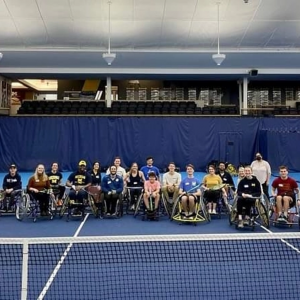
Attendees at RX to Play Day: Wheelchair Tennis
Another successful series of events that MSDHA has helped organize, along with U-M Adaptive Sports & Fitness and the PM&R Interest Group, is Rx to Play Day. Rx to Play Day is a series of demo days where students have the opportunity to learn how to play various adaptive sports, such as wheelchair basketball and tennis. Jessica Wynne, Head Coach of U-M Wheelchair Basketball, Chuck Aoki, Wheelchair Rugby Paralympian, and Dr. Oluwaferanmi Okanlami, Director of Student Accessibility and Accommodation Services at U-M and Adaptive Sports Director, taught attendees about wheelchair basketball, guided them through drills, and set up a full court game. The goal of the program is to be an informal and safe space to gain experience with adapted sports in the hopes that we can continue to expand awareness and access to health and wellness.

Blake Hardin (M1), Dr. Okanlami, Kate Panzer (M3), and Dana Chung (M1) presenting at the 2023 Diversity in Medicine conference.
As a chapter of Medical Students with Disability and Chronic Illness (MSDCI) National, MSDHA members can collaborate on national disability advocacy initiatives. Medical students have the opportunity to develop advocacy skills, network with like-minded individuals, and work towards creating a more inclusive and accessible medical community across the country.
MSDHA’s initiatives not only benefit medical students but also have a positive impact on the broader community. Through education and advocacy, MSDHA works towards reducing health disparities experienced by individuals with disabilities and chronic illnesses. The organization’s efforts create a more inclusive medical profession that understands and values the unique experiences and perspectives of individuals with disabilities.
MSDHA is an excellent organization for medical students interested in disability health and advocacy. The organization provides opportunities for students to contribute to disability health initiatives, build a supportive community, and collaborate on national advocacy initiatives. MSDHA’s efforts are crucial for creating a more inclusive and accessible medical community that values and supports individuals with disabilities and chronic illnesses at the University of Michigan and beyond.
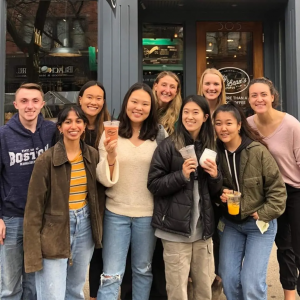
MSDHA social event at Bitty & Beau’s coffee shop in Ann Arbor.
My involvement in MSDHA has reaffirmed why I wanted to go in medicine in the first place: to advocate and care for patients with disabilities and chronic illnesses by merging compassionate patient-centered care with evidence-based medicine.
Blake Hardin is a first-year medical student at University of Michigan Medical School and one of the Co-Presidents of Medical Students for Disability Health and Advocacy (MSDHA). When he’s not cramming for his next quiz/exam, you can find him binge-playing videogames and singing with the UMMS a cappella group, Auscultations. He can be followed on Twitter at @Blake347.













 It is an honor to be with patients in these moments and support them in ways that we can. However, sometimes it feels like there are constraints within the healthcare system — we leave these patient interactions wishing there was more we could do to change these peoples’ circumstances. This desire to drive positive change for patients beyond the one-on-one clinical setting often takes shape in the form of advocacy work.
It is an honor to be with patients in these moments and support them in ways that we can. However, sometimes it feels like there are constraints within the healthcare system — we leave these patient interactions wishing there was more we could do to change these peoples’ circumstances. This desire to drive positive change for patients beyond the one-on-one clinical setting often takes shape in the form of advocacy work.  At the end of the course, students had the opportunity to travel to Lansing, where they spoke with Washtenaw County’s Rep. Carrie Rheingans and Sen. Jeff Irwin. Some students interested in emergency medicine elected to travel to Washington, D.C. and attend the American College of Emergency Physician’s Leadership and Advocacy Course with Dr. Uren. In future classes, students may also travel to the American Medical Association’s National Advocacy Conference in Washington DC. Other opportunities may be available for students with other specialty interests as well.
At the end of the course, students had the opportunity to travel to Lansing, where they spoke with Washtenaw County’s Rep. Carrie Rheingans and Sen. Jeff Irwin. Some students interested in emergency medicine elected to travel to Washington, D.C. and attend the American College of Emergency Physician’s Leadership and Advocacy Course with Dr. Uren. In future classes, students may also travel to the American Medical Association’s National Advocacy Conference in Washington DC. Other opportunities may be available for students with other specialty interests as well.



